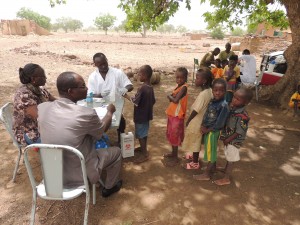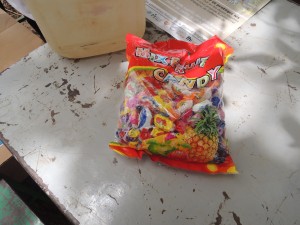Transmission Assessment Surveys: Where the Rubber Meets the Road
July 30th, 2013
When it comes to transmission assessment surveys (TAS), the results are black and white. Communities in Burkina Faso either pass the test, or they fail–there’s no such thing as a middle ground. After all, what’s at stake is nothing less than peoples’ health, and by extension, their entire quality of life.
Back in 2006, a total of 63 districts in the West African country of Burkina Faso were confirmed as endemic and needing treatment for lymphatic filariasis (LF), one of several neglected tropical diseases affecting that country. Following that confirmation, the country’s Neglected Tropical Diseases Program (NTDP) within its Ministry of Health (MOH), with financial and administrative support since September 2010 from the USAID-funded END in Africa projects as well as operational support from Helen Keller International, began providing residents of the endemic communities with the drugs ivermectin (also known as Mectizan®) and albendazole, to prevent and treat that disease.
To maximize the effectiveness of the drugs in preventing the spread of LF, Burkina Faso’s NTDP used the World Health Organization (WHO)-recommended treatment modality known as mass drug administration (MDA), which entails giving drugs once a year for at least six years to everyone living in each endemic community, regardless of whether they have the disease.
After providing MDA to a number of endemic districts for at least six years, the manager of the NTDP knew it was time for the ultimate test of LF control–the formal Transmission Assessment Survey (TAS). And so, the NTDP trained their cadre of lab technicians using the WHO protocol for doing TAS on May 27-30, 2013; and the TAS itself started in early June.
The TAS involved collecting blood samples from 6- and 7-year-old children in schools and communities selected for the survey. Following collection, the samples were tested by the trained lab technicians using a specialized tool called an immunochromatographic test (ICT) card. ICT cards detect whether or not the children’s blood contains the antigen produced by the microbiotic adult w. Bancrofti worm, which causes LF infections in Africa.
Since the children in this age-group were born during the years when MDA was being provided to their communities, they should test negative for the antigen as long as everyone in the community actually took the drugs, which kill the disease-causing microbe and thus, prevent their ever being exposed to the disease.
Based on the results of the TAS, program managers decide whether the disease transmission rate has reached levels low enough to safely stop providing mass drug administration (MDA) in endemic communities. WHO has provided specific values called “critical cut-off” that are used to make this decision. If the results of the TAS show that the number of children who test positive does not exceed the critical cut-off value, MDA is stopped. If the opposite happens and the number of positive children exceeds the critical cut-off value, annual MDA is continued for at least 2 more years, following which time the TAS process is repeated.
The good news for Burkina Faso and its NTDP is that previous TAS have shown that the program’s hard work is really paying off! The country has already been able to stop MDA treatments in 16 out of 63 districts, since TAS results revealed that prevalence of LF in those districts had reached the WHO-determined critical threshold where transmission is no longer sustainable, even without treatment. The results of the TAS conducted in June-July 2013, will be used to decide if MDA should be stopped in another 7 districts in 2 regions: Boucle du Mouhoun (3 districts) and Centre-Nord (4 districts).
Just to be sure that the disease is really gone for good, Burkina Faso’s NTDP still does post-MDA surveillance in those 16 districts to detect any sign of the disease’s return. At the same time, it is still providing MDA in the remaining 47 districts that have not yet reached the critical threshold to stop treatment. The NTDP hopes to be able to reduce that number to 40 soon, if the 7 districts now being assessed pass the test.
As more districts in Burkina Faso and the other END in Africa countries complete the required six rounds of MDA treatment for LF, more NTDPs will do TAS in their LF-endemic districts to determine when it’s safe to stop drug treatments. And as more national NTDPs begin to focus on assessing their results, learning the ins and outs of doing TAS will become increasingly important. For details on TAS and how to conduct TAS please refer to the following documents that can be accessed via the World Health Organization website:
- WHO (2011) Monitoring and epidemiological assessment of mass drug administration in the global programme to eliminate lymphatic filariasis: a manual for national elimination programmes. Geneva: World Health Organization.
- WHO (2011) Transmission assessment surveys in the Global Programme to Eliminate Lymphatic Filariasis: WHO position statement. Geneva: World Health organization.





